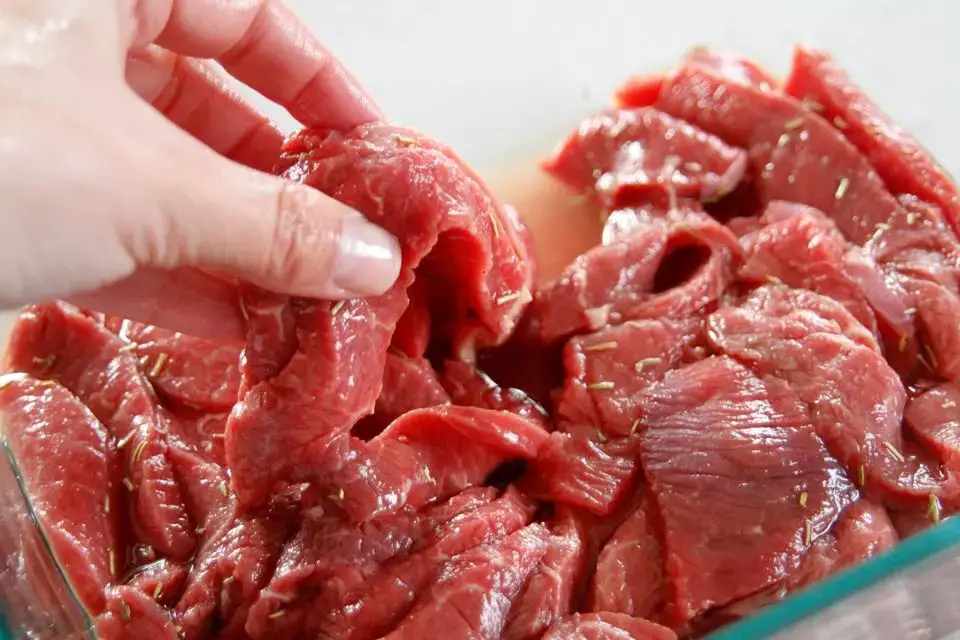What is Dog Jerky?
Dog jerky, also known as dog meat jerky, refers to dried strips of dog meat that are often packaged and sold as dog treats. It is commonly made from flank or round muscles of dogs bred and raised for meat production. The meat is sliced into thin strips and dried using salt and spices to help preserve it. Flavors like chicken, turkey, and beef are sometimes added through marinades or flavorings to alter the final taste.
To make dog jerky, the raw dog meat is first sliced into strips before being dried slowly at low temperatures. This drying process extracts moisture from the meat, which helps preserve it. Spices, seasonings and smoke are also often used to add flavor. The final product is shelf-stable, chewy strips of dried dog meat that can be eaten as snacks.
Is It Safe for Human Consumption?
Generally, eating dog jerky is not recommended by health authorities for human consumption. There are risks associated with disease transmission if the meat is not properly cooked and prepared. Additionally, there are ethical concerns around eating companion animals like dogs that give many people pause.
Dog meat that is not handled properly can transmit diseases like rabies to humans. Proper cooking and preparation are essential to kill potential pathogens before eating. However, many health agencies advise avoiding dog meat altogether, as oversight and regulation of the dog meat trade are often lacking.
There are also ethical dilemmas around eating domesticated companion animals. Dogs have a long history of bonding with humans, and the thought of eating dog meat upsets many people’s sensibilities, especially in Western cultures where dogs are commonly kept as pets. The methods of slaughter and cruelty present in parts of the unregulated dog meat trade also compound ethical uneasiness with eating dogs.
While the consumption of dog meat is uncommon and taboo in most Western societies, it does have a long history in some Asian countries. However, due to increasing ethical concerns, the practice has declined significantly in countries like South Korea, though it still persists in some regions. Overall, from both a health and ethical perspective, eating dog meat is generally ill-advised.
Risk of Foodborne Illnesses
There are risks of contracting foodborne illnesses from eating dog jerky due to diseases that can spread from dogs to humans. Dogs can carry diseases like rabies, ringworm, and tapeworms that can be transmitted through their meat if not properly handled and cooked. Just as with any raw meat product, contamination can occur during processing if sanitation practices are inadequate.

Proper cooking and preparation of dog jerky can help reduce risks of foodborne illnesses. The high temperatures needed to create jerky help kill parasites and other pathogens. However, cross-contamination after cooking is still a concern if the meat is not handled properly. Contamination can occur during slicing, drying, packaging and storage stages if equipment and facilities are not adequately cleaned.
Overall, consuming dog jerky does come with an elevated risk of foodborne disease transmission compared to commercial sources of cooked jerky. Care would need to be taken during processing and cooking to minimize contamination. Even then, the possibility of disease transmission may still be too high for many to accept.
Nutritional Profile
Dog jerky, like other animal meats, is a good source of protein. The exact nutritional profile can vary significantly depending on the breed of dog and its diet. In general, dog meat contains around 18-25% protein, with levels comparable to beef, chicken, pork, and other commonly consumed meats.
The fat content of dog meat also depends on the breed and diet, but is moderate and similar to other meats like lamb and goat. Dog meat has lower saturated fat compared to beef or pork. Essential fatty acids like omega-3s can also be present depending on the dog’s diet.
Dog meat, organs, and bones can provide minerals like iron, magnesium, selenium, potassium and zinc. Micronutrients will also depend on the whole diet of the dog. Dog meat lacks some vitamins like A and C compared to muscle meats like beef and pork.
Overall, dog meat is nutritionally similar to other commonly consumed livestock meats. It is high in quality protein and B vitamins. The exact nutrition profile varies based on breed, diet, and butchery methods.
Cultural History of Consumption
The consumption of dog meat has occurred in some Asian and Arctic communities for centuries as part of their food culture and traditions. Certain ethnic groups in China, Vietnam, Korea, and other parts of Asia have considered dog meat a delicacy and source of protein. There is also evidence of humans eating dog meat as far back as the Neolithic era in Europe. In the Arctic, Inuit sled dogs were occasionally eaten by their owners when other food sources were scarce.
However, eating dog meat has long been taboo in most Western cultures. Dogs have held special significance as companions, workers, and pets in European and American societies since ancient times. While not illegal, consuming dog meat is met with disgust, outrage and stigma in much of the Western world today. There are significant ethical concerns around the humane treatment of dogs, even when raised for meat rather than as pets or working animals. This cultural divide has led to tensions and controversy around the global dog meat trade.
With growing awareness of animal welfare and interest in protecting dogs from cruel practices, the custom of eating dog meat faces increasing criticism internationally. Though historical traditions persist in some regions, many advocates argue that these practices are outdated and should end, while others believe it is a matter of cultural relativity. The debate continues around whether any dog meat consumption can be considered ethical or socially acceptable today.
Legal Status Around the World
The legality of consuming dog meat varies greatly around the world. In the United States and Canada, it is strictly prohibited to sell dog meat or products intended for human consumption. Several U.S. states, including California, Georgia, Michigan, New York, and Virginia, have explicit bans on the slaughter and consumption of dogs and cats.
Some Asian countries, including Taiwan, Philippines and Hong Kong, also have bans on dog meat consumption. In parts of India, it is illegal to sell and eat dog meat. However, the practice persists despite legal restrictions in parts of rural India.
In many European nations like Switzerland, France, and Germany, consuming dog meat is technically legal. However, cultural norms generally discourage the practice in most of Europe.
In parts of Africa, including Ghana, the Republic of Congo and Nigeria, dog meat is considered a delicacy and the laws around preparation and sale are minimal. Regulations focus more on humane slaughter.
South Korea has no specific ban on dog meat consumption, though regulations require farmed dogs to be slaughtered humanely. Dog meat restaurants operate openly in South Korea, though the practice is declining in popularity.
Thus, while dog meat consumption is strictly banned in some Western nations, it remains legal and culturally accepted in parts of Africa and Asia.
Alternatives for Human Consumption
For those seeking the texture and flavor of jerky without the ethical concerns of consuming dog meat, there are several alternatives to consider:

Other Animal-Derived Jerky
Jerky can be made from the meat of other animals like turkey, beef, bison, and venison. These types of jerky are widely available at grocery stores and specialty shops. Look for quality jerky made from whole cuts of meat without too many artificial ingredients.
Plant-Based Jerky
For vegetarians and vegans, there are plant-based jerky options made from ingredients like soy, wheat gluten, mushrooms, and jackfruit. Popular brands include Primal Spirit Foods, Louisville Vegan Jerky Co., and Unjerky. You can also find plant-based jerky recipes to make at home.
Homemade Jerky Recipes
Making homemade jerky allows you full control over the ingredients and quality of the finished product. Meat like flank steak or chicken breast can be sliced thinly and marinated before dehydrating or baking. There are also recipes for homemade vegan jerky using vital wheat gluten or mushrooms.
With some preparation and experimentation, homemade jerky can be customized to suit any taste or dietary need. It makes for a flavorful and protein-packed snack without the ethical complications of commercial dog jerky.
Sourcing Dog Jerky Ethically
If dog jerky is being locally and ethically produced in your area, it’s possible to source it humanely. However, the high demand for dog meat globally has led to inhumane practices. The best way to ethically source dog jerky is to adopt dogs rather than shop for them. Reducing demand for commercially bred dogs lowers the demand for dog meat.
When sourcing dog jerky, ensure the farm or provider adheres to lawful practices and treats the animals humanely throughout their lives. Seek out small, local producers with high standards of animal welfare over mass producers. Responsible producers should raise dogs humanely, provide proper veterinary care, and use lawful, painless slaughter methods.
While cultural and regional differences exist around dog meat, the priority should be ensuring humane practices. Boycotting products from regions where dog meat is accepted could punish lawful producers adhering to ethical standards. A more effective approach is supporting producers who demonstrate high standards of animal welfare.
Cultural Sensitivity Around Dog Meat
The consumption of dog meat, while taboo in many cultures, has long been a part of traditional cuisines in some regions of the world. However, the practices surrounding dog meat have rightly come under scrutiny due to animal welfare concerns. There are humane ways forward that balance cultural sensitivity with ethical progress.

Rather than condemnation, open and respectful dialogue focused on incremental change is needed. Outright bans often drive the slaughter of dogs underground, which can make conditions even worse. Each society evolves at its own pace, and cultural attitudes cannot be forcibly eliminated overnight. With patience and nuance, it may be possible to transition communities toward more humane practices and preferences over time.
The goal should be defending the welfare and dignity of animals while understanding the personal and economic factors that make this a complex socio-cultural issue. Progress requires long-term investments in education, proposing alternatives, and uplifting ethical voices within diverse communities. Most people agree that all animals deserve humane treatment in life and death. With compassion on all sides, societies can collectively work to align ideals with reality.
Conclusions
In summary, while some cultures have a tradition of consuming dog meat and jerky, there are significant health risks involved that make it inadvisable to eat for most people. Consuming dog meat increases the risk of contracting foodborne illnesses like rabies and trichinosis. Additionally, there are ethical concerns around the inhumane treatment of dogs in parts of the world where the dog meat trade is active. For those looking for an alternative source of protein or jerky, there are safer and more ethical options available. Ultimately, while prohibitions around dog meat are culturally relative, the potential health hazards make it an unwise choice for human consumption.
To conclude, while dog jerky may be a part of some food traditions, it is generally not recommended for people to eat for both health and ethical reasons. It is best to avoid dog meat and seek out alternative protein sources. The insights provided on the risks, nutritional value, and ethical debate over dog jerky consumption hopefully leave readers with a comprehensive understanding of this controversial food item.
